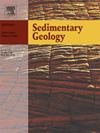伊比利亚半岛富腹足类湖相碳酸盐沉积:晚中新世的沉积、气候和生态记录
IF 2.9
2区 地球科学
Q1 GEOLOGY
引用次数: 0
摘要
Tortonian Peña Adrian组是Miranda-Trebiño盆地(巴斯克-坎塔布里亚比利牛斯山脉)中最年轻的沉积单元,该盆地于晚始新世至晚中新世发育于南巴斯克-坎塔布里亚比利牛斯山脉。该地层为50 ~ 160 m厚的冲积碎屑级配湖相碳酸盐岩序列,含有丰富多样的钙质化石生物群(腹足类、介形虫和蕨类)。化石组合的特点是暖温带浅湖,底部有植被,淡水含氧良好,碱性强。综合地层学、沉积学、古生物学和CO稳定同位素数据,可以区分各种沉积相,建立沉积模式,定义不同的演化阶段及其与异源过程的关系。高达3米厚的相序列记录了重复的水位变化,可能反映了短期气候变化。总体而言,演替勾勒出一个在振荡气候条件下逐渐扩张和快速收缩的浅斜坡状湖泊系统的不对称循环。C和O稳定同位素随时间的变化与盐度的降低和降水/蒸发平衡的增加相一致。开放湖相沉积具有文石和双矿物腹足类保存完好的特点,而湖相沉积则具有明显的壳溶作用和新形作用。钙质生物群保存的不同程度清楚地反映了沉积和早期埋藏期间的物理化学条件的变化。这些发现增加了对碳酸盐湖盆的认识,有助于识别控制其演化的因素,并突出了富含腹足类的碳酸盐记录的特定沉积和保存条件。本文章由计算机程序翻译,如有差异,请以英文原文为准。
Gastropod-rich lacustrine carbonate deposits in N Iberia: a depositional, climatic and ecological record of the Late Miocene
The Tortonian Peña Adrian Formation represents the youngest depositional unit of the Miranda-Trebiño basin (Basque-Cantabrian Pyrenees), which developed on the Southern Basque-Cantabrian Pyrenees from late Eocene to Late Miocene times. The formation is a 50–160 m thick succession of alluvial detrital grading to lacustrine carbonates that contain rich and varied calcareous fossil biota (gastropods, ostracods and charophytes). The fossil association characterizes warm temperate, shallow lakes with vegetated bottoms and well‑oxygenated and alkaline fresh waters. Integration of stratigraphic, sedimentological, paleontological and C![]() O stable isotopic data allows the differentiation of a wide range of sedimentary facies, the construction of a depositional model and the definition of distinct evolutionary phases and relation to allogenic processes. Up to 3 metre-thick facies sequences record repetitive water-level changes, likely reflecting short-term climate changes. Overall, the succession outlines an asymmetric cycle of gradual expansion and faster contraction of a shallow ramp-like lake system evolving under oscillating climatic conditions. C and O stable isotopes are consistent with decreasing salinity and increasing precipitation/evaporation balance trough time. Excellent preservation of aragonitic and bimineralic gastropods characterizes the open lacustrine deposits, whereas shell dissolution and neomorphism are distinct in the palustrine ones. This contrasting degree of preservation of calcareous biota clearly reflects changes in the physico-chemical conditions that prevailed during sedimentation and early burial. The findings add to the knowledge of carbonate lake basins, help discern the factors that controlled their evolution and highlight specific depositional and preservation conditions for gastropod-rich carbonate records.
O stable isotopic data allows the differentiation of a wide range of sedimentary facies, the construction of a depositional model and the definition of distinct evolutionary phases and relation to allogenic processes. Up to 3 metre-thick facies sequences record repetitive water-level changes, likely reflecting short-term climate changes. Overall, the succession outlines an asymmetric cycle of gradual expansion and faster contraction of a shallow ramp-like lake system evolving under oscillating climatic conditions. C and O stable isotopes are consistent with decreasing salinity and increasing precipitation/evaporation balance trough time. Excellent preservation of aragonitic and bimineralic gastropods characterizes the open lacustrine deposits, whereas shell dissolution and neomorphism are distinct in the palustrine ones. This contrasting degree of preservation of calcareous biota clearly reflects changes in the physico-chemical conditions that prevailed during sedimentation and early burial. The findings add to the knowledge of carbonate lake basins, help discern the factors that controlled their evolution and highlight specific depositional and preservation conditions for gastropod-rich carbonate records.
求助全文
通过发布文献求助,成功后即可免费获取论文全文。
去求助
来源期刊

Sedimentary Geology
地学-地质学
CiteScore
5.10
自引率
7.10%
发文量
133
审稿时长
32 days
期刊介绍:
Sedimentary Geology is a journal that rapidly publishes high quality, original research and review papers that cover all aspects of sediments and sedimentary rocks at all spatial and temporal scales. Submitted papers must make a significant contribution to the field of study and must place the research in a broad context, so that it is of interest to the diverse, international readership of the journal. Papers that are largely descriptive in nature, of limited scope or local geographical significance, or based on limited data will not be considered for publication.
 求助内容:
求助内容: 应助结果提醒方式:
应助结果提醒方式:


